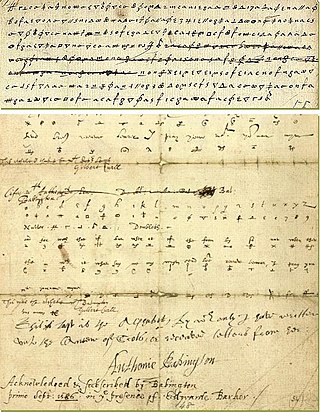Related Research Articles

Robert Persons, later known as Robert Parsons, was an English Jesuit priest. He was a major figure in establishing the 16th-century "English Mission" of the Society of Jesus.

Henry Garnet, sometimes Henry Garnett, was an English Jesuit priest executed for high treason, based solely on having had advanced knowledge of the 1605 Gunpowder Plot and having refused to violate the Seal of the Confessional by notifying the authorities. Born in Heanor, Derbyshire, he was educated in Nottingham and later at Winchester College before he moved to London in 1571 to work for a publisher. There he professed an interest in legal studies and in 1575, he travelled to the continent and joined the Society of Jesus. He was ordained in Rome some time around 1582.
William Watson was an English Roman Catholic priest and conspirator, executed for treason.

Francis Tresham was a member of the group of English provincial Catholics who planned the failed Gunpowder Plot of 1605, a conspiracy to assassinate King James I of England.

Robert Southwell, SJ, also Saint Robert Southwell, was an English Catholic priest of the Jesuit Order. He was also an author of Christian poetry in Elizabethan English, and a clandestine missionary in Elizabethan England.
The Bye Plot of 1603 was a conspiracy, by Roman Catholic priests and Puritans aiming at tolerance for their respective denominations, to kidnap the new English king, James I of England. It is referred to as the "bye" plot, because at the time it was presented as a minor component of a larger plot.

The Castle at Wisbech was a stone motte-and-bailey castle built to fortify Wisbech on the orders of William I in 1072, it probably replaced an earlier timber and turf complex. The layout was probably oval in shape and size, on the line still marked by the Circus. The original design and layout is unknown. It was rebuilt in stone in 1087. The castle was reputedly destroyed in a flood in 1236. In the 15th century, repairs were becoming too much for the ageing structure, and a new building was started in 1478 under John Morton, Bishop of Ely. His successor, John Alcock, extended and completed the re-building and died in the Castle in 1500. Subsequent bishops also spent considerable sums on this new palace. The Bishop's Palace was built of brick with dressings of Ketton Stone, but its exact location is unknown.
William Bishop was an English Catholic prelate who served as the first Catholic bishop in England after the Reformation, serving as Vicar Apostolic of England.
Christopher Bagshaw was an English academic and Roman Catholic priest.
Father George Blackwell was Roman Catholic Archpriest of England from 1597 to 1608.
The Archpriest Controversy was the debate which followed the appointment of an archpriest by Pope Clement VIII to oversee the efforts of the Roman Catholic Church's missionary priests in England at the end of the sixteenth century.

Charles Paget was a Roman Catholic conspirator, involved in the Babington Plot to assassinate Queen Elizabeth I of England.

The Colleges of St Omer, Bruges and Liège were successive expatriate institutions for Roman Catholic higher education run by the Jesuits for English students.

William Weston, SJ was an English Jesuit missionary priest. He was appointed superior of the Jesuits on the English Mission.
John Mush was an English Roman Catholic priest, the confessor to Margaret Clitherow.
Thomas Lister was an English Jesuit writer.
Thomas Graves Law (1836–1904) was an English Oratorian priest, and later in life a historian and bibliographer.
John Bavant or Bavand alias Clarke was an English Roman Catholic priest. He was a well-respected teacher and scholar at Oxford, and served as the rector of Solihull during the 1560s, but eventually converted to Roman Catholicism and led the rest of his long life as an active missionary and ecclesiastical administrator.
John Colleton (1548–1635) was an English Roman Catholic priest.

The Oath of Allegiance of 1606 was an oath requiring English Catholics to swear allegiance to James I over the Pope. It was adopted by Parliament the year after the Gunpowder Plot of 1605. The oath was proclaimed law on 22 June 1606, it was also called the Oath of Obedience. Whatever effect it had on the loyalty of his subjects, it caused an international controversy lasting a decade and more.
References
- Carrafiello, Michael L. (1998), Robert Parsons and English Catholicism, 1580-1610, Susquehanna University Press, p. 89, 93, ISBN 978-1-57591-012-3
- Law, Thomas Graves (1889), Historical Sketch of the Conflicts between Jesuits and Seculars in the reign of Queen Elizabeth, Scotland: David Nutt